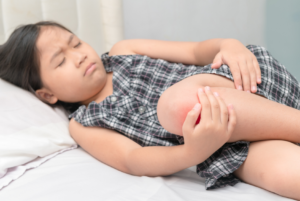 If you’ve ever heard your child say their legs are achy, and wondered if they’re just tired or if it could be something more, this is for you. As parents, we understand the battle between hoping that it’s fine and the pain will resolve, and deciding whether to bring them in for a check-up. To help, we’ve asked our team to put together the common causes they see for achy legs in children’s podiatry appointments, so you better can understand what could be going on.
If you’ve ever heard your child say their legs are achy, and wondered if they’re just tired or if it could be something more, this is for you. As parents, we understand the battle between hoping that it’s fine and the pain will resolve, and deciding whether to bring them in for a check-up. To help, we’ve asked our team to put together the common causes they see for achy legs in children’s podiatry appointments, so you better can understand what could be going on.
1. It’s their foot posture
Foot posture dictates the way that your muscles, ligaments and bones will function when walking, running and playing. Having flat feet, for example, can overwork the muscles that travel down the legs and into the feet. These muscles already work hard at every step to help you lift the feet and legs, take a step, stay balanced, walk efficiently, and much more. When they have to work harder with every step, every day, it’s not surprising that they may feel tired and achy.
In this case, it’s important to notice the difference between leg aches (muscle fatigue) and leg pain, which may be a sign that muscle or tendon damage has occurred.
2. It’s time for new shoes
Good shoes provide support, stability and comfort for growing feet. They help ease the load on the feet and legs, meaning muscles don’t have to work so hard. They keep the feet moving forwards while using less energy, as opposed to wobbling from side to side during the process.
When shoes get worn down, they lose the ability to perform these important tasks. Whether the sole becomes worn down on one side or the shoes lose the strength they once had, the feet and legs start working harder to compensate for what the shoes used to provide. As the feet and legs aren’t used to this extra load, aches can begin, especially if your little ones are often active on their feet.
Thankfully, this is a simple and easy fix, and getting new shoes is the answer. If you’re unsure about how to choose the right school shoes for your kids, click here.
3. Growing pains have started
Between the ages of 8 and 14, kids may start to experience growing pains. Growing pains occur when there is an imbalance between how quickly their bones are growing, and how rapidly their muscles are lengthening.
A faster-growing bone puts higher tension on the connecting muscles. This tightness irritates the vulnerable part of a growing bone called the growth plate, and pain occurs, often with an accompanying ache in the tight muscles. This often occurs in the heels and calves, as well as the shins and knees.
The good news is that once this cause is diagnosed and the affected muscles and bones are identified, the treatment plan to help lengthen the muscles, settle the painful symptoms, and keep the lower limbs supported is straightforward. Just make sure you work with a podiatry team that is experienced in the safe and effective management of children’s foot problems (did we mention that one in three of all our patients are kids?).
To learn more about growing pains, click here.
4. They have hypermobility
Up to 27% of kids may have hypermobile joints. Hypermobility is a condition where the joints can easily exceed a ‘normal’ range of movement. This makes kids seem very flexible, even if they haven’t trained or stretched.
While hypermobility itself may be relatively painless, the effects on the muscles may cause achy feet and legs. As the joints are less stable due to more flexible ligaments, muscles may need to work overtime to keep the joints stable and well-aligned. When muscles need to do this day after day, especially as the body grows, changes and becomes heavier, aches can occur.
Managing hypermobility involves identifying the affected areas, and improving the body’s stability and strength, so the muscles can work at the normal pace they were designed for.
5. Muscle strains
While there are many other less common causes of achy legs, like stress fractures and juvenile arthritis, you may be right in thinking that they’ve had a big day on their feet and are feeling the consequences. In this case, it’s important to differentiate between delayed onset muscle soreness that will pass in a few days, or damage that can get worse if it is left untreated.
A good place to start is feeling the leg and foot muscles. If certain spots that are significantly more painful to touch than others, significant damage may have occurred. In this case, it’s important to have your kids assessed, to reduce the risk of the injury worsening.
If you’re worried about bringing your child in unnecessarily, please don’t. At My FootDr, we take a very proactive approach to kids’ health, and believe that it’s better to be safe than sorry. There is no problem too big or too small – if it matters to you, it matters to us.
Book your child’s appointment by calling 1800 FOOTDR or clicking here.


